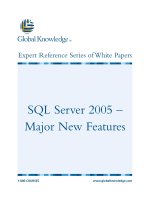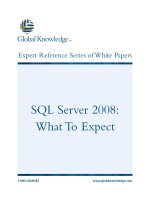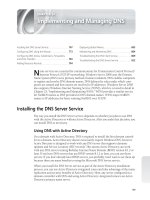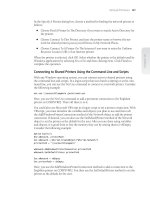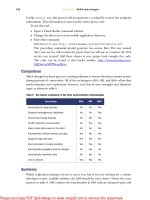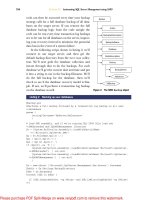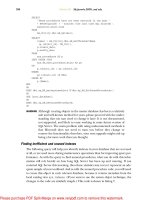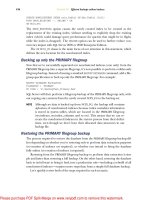Tài liệu SQL Server 2005 – Major New Features pptx
Bạn đang xem bản rút gọn của tài liệu. Xem và tải ngay bản đầy đủ của tài liệu tại đây (344.32 KB, 8 trang )
SQL Server 2005 –
Major New Features
1-800-COURSES
www.globalknowledge.com
Expert Reference Series of White Papers
SQL Server 2005 Analysis Services (SSAS)
Microsoft Analysis Services is server-based platform for on-line analytical processing (OLAP) and Data Mining
Services provided with Microsoft SQL Server 2005.
This tool is not new, but it has been completely rewritten from the ground up. While Analysis Services 2000 was
more of an evolutionary release building on the same OLAP architecture that Microsoft (MS) introduced with
SQL 7,
the new version of SSAS is a fundamental change, built on Unified Dimensional Model (UDM).
Microsoft
released SSAS in November 2005, and it ships as an add-on to SQL Server 2005 just like its predecessors.
Business Intelligence – The Big Picture
SSAS is an integral part of the Microsoft Business Intelligence (BI) platform that w
as initiated in early 2004.
Business Intelligence is a general term describing innovative use of technology for processing large volumes of
corporate data and turning it into useful information that facilitates decision-making. While BI is not a new con-
cept, the underlying technology made actual implementations prohibitively expensive and available mostly to the
upper echelon of management. The goal of SSAS 2005 is to ”democratize” the process and to provide instant
information readily available to the entire organization – or what MS calls “pervasive business intelligence” (PBI).
The MS BI Platform is a multi-product offering that includes SSAS and other components. The two major build-
ing blocks of Microsoft BI Platform are SQL Server and Office System. The back-end analytics engine provided
by SQL Server is supplemented with the user interface provided by Office System. Furthermore, the Microsoft
BI Platform integrates with different enterprise data stores. This allows for a single interface that draws raw
data from multiple data sources, without requiring modifications to existing applications. A typical BI imple-
mentation is depicted in
Figure 1 on the next page.
Scope of this Paper
A white paper on SSAS 2005 could easily become a book.
T
herefore
, this paper will focus on its major new fea-
tures. It will highlight the user interface and the architecture changes in the new SSAS 2005 and compare
them with their 2000 counterparts. Beyond the scope of this paper are the topics of Data Transformation
Services, Data Mining, Multidimensional Expressions (MDX) language, Reporting Services, and SQL Server 2005
itself. I have also included at the end of the paper some links for further information.
Sue Cooney, Global Knowledge Course Director, MIS, MCSA, MCSE+ I, MCT
SQL Server 2005 – Major New Features
Copyright ©2006 Global Knowledge T
raining LLC. All rights reserved.
Page 2
Copyright ©2006 Global Knowledge T
raining LLC. All rights reserved.
Page 3
F
igure 1.
Differences between SQL 2000 and SQL 2005 BI
Components
The following table summarizes the differences between the BI components of SQL Server 2000 and SQL
server 2005.
Source: />In this paper I will discuss the user interface and architectural differences between AS for SQL Server 2000 and
SSAS for SQL Server 2005.
User Interface
New Administrative Tools
SSAS 2005 offers administrative tools based on the type of activities they support--either development or man
-
agement. This is a new approach compared to SQL 2000 where, for example, Analysis Manager supported both
development and management activities.
The new
Business Intelligence Development Studio (BIDS) is single suite of development and mainte-
nance tools that replaces SQL Server 2000 Enterprise Manager
,
Analysis Services Manager, and Query Analyzer.
It allows a DBA or a SQL developer to define a cube or a mining model.
Copyright ©2006 Global Knowledge T
raining LLC. All rights reserved.
Page 4
Component SQL Server 2000 SQL Server 2005
Extract, transformation, and load Data Transformation Services (DTS) SQL Server 2005 Integration Services
Relational data warehouse SQL Server 2000 relational database SQL Server 2005 relational database
Multidimensional database SQL Server 2000
Analysis Services
SQL Server 2005
Analysis Services
Data mining SQL Server 2000 Analysis Services SQL Server 2005 Analysis Services
Managed reporting SQL Server 2000 Reporting Services SQL Server 2005 Reporting Services
Ad hoc reporting Not applicable SQL Server 2005 Reporting Services
Ad hoc query and analysis Microsoft Office products (Excel, Office
Web Components, Data Analyzer,
SharePoint Portal Server)
Microsoft Office products (Excel, Office
Web Components, Data Analyzer,
SharePoint Portal Server)
Database development tools SQL Server 2000 Enterprise Manager,
Analysis Manager, Query Analyzer, vari-
ous other tools
SQL Server 2005 Business Intelligence
Development Studio (New)
Database management tools Enterprise Manager, Analysis Manager SQL Server Management Studio (New)
Another new tool is SQL Server Management Studio (SSMS), previously referred to as the SQL Server
Workbench.
It combines the functionality of Enterprise Manager and
Analysis Manager into one tool. This allows
DBAs to manage deployed applications including backup/restore
, browsing data, and scripting. The Query Editor
in SSMS allows users to write and execute T-SQL statements. Graphical queries are also supported.
Both newcomers are based on
V
isual Studio Development Environment.
Copyright ©2006 Global Knowledge T
raining LLC. All rights reserved.
Page 5

